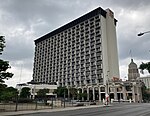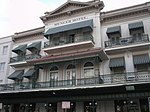La Antorcha de la Amistad
2002 sculpturesMexican-American culture in San AntonioMexico–United States relationsOutdoor sculptures in San AntonioSteel sculptures in Texas
La Antorcha de la Amistad (Spanish for "The Torch of Friendship") is a monumental abstract sculpture by Mexican sculptor Sebastián, installed in Downtown San Antonio, in the U.S. state of Texas. The work was commissioned by a group of Mexican businessmen living in the United States and friends of Mexico, and presented as a gift from the Mexican government to the City of San Antonio in 2002. It was unveiled on June 27, 2002, by the artist, Mayor Edward D. Garza, and then–Secretary of Foreign Affairs for Mexico and political analyst Jorge Castañeda Gutman.
Excerpt from the Wikipedia article La Antorcha de la Amistad (License: CC BY-SA 3.0, Authors).La Antorcha de la Amistad
South Alamo Street, San Antonio
Geographical coordinates (GPS) Address Nearby Places Show on map
Geographical coordinates (GPS)
| Latitude | Longitude |
|---|---|
| N 29.4234 ° | E -98.4874 ° |
Address
250th Anniversary of the Founding of San Antonio
South Alamo Street
78205 San Antonio
Texas, United States
Open on Google Maps










